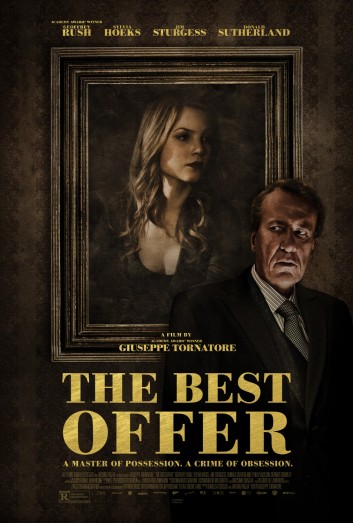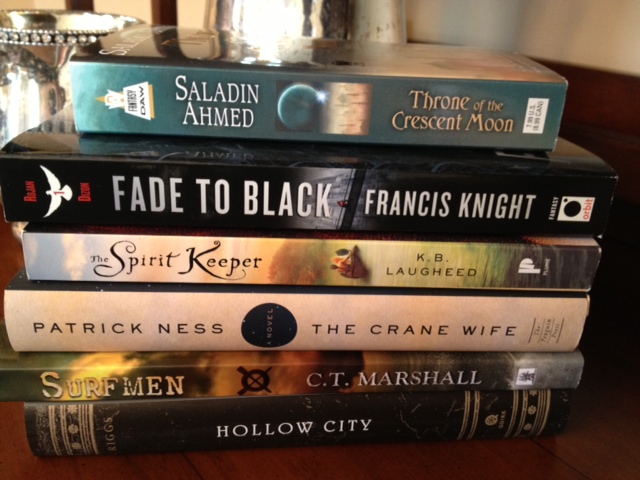The Best Offer, Mr. Selfridge, and a Peek at My TBR Pile #movies #books
The Best Offer
I recently rented The Best Offer and, despite its lackluster reviews (52% on Rotten Tomatoes), I liked it and think it’s well worth watching and discussing. First off, who doesn’t love Geoffrey Rush? Anyone who can play Barbossa, the Marquis de Sade, and the man who had the gall to give a king elocution lessons will always be a favorite of mine. For anyone unfamiliar with the movie, it’s about an art auctioneer who is both obsessed and terrified by female beauty. Needless to say, he’s a bit of a loner and eccentric. (Let’s face it, he has mild OCD, although he is a master at his craft, allowing him to live a life full of luxury, opulence, and two-dimensional relationships).
In any case, he gets involved with a hermit heiress and begins the process of inventorying and valuing all of the art and furniture in her family’s crumbling, rambling villa. Soon, other story elements come into play: rusty gears and broken pieces from an antique automaton, a portrait of a ballerina, a young Romeo who also happens to be a machinist, a brilliant female mathematician, and a middling painter cum art thief accomplice – all set against the backdrop of the old villa, which give parts of the movie a gothic tone.
But the real reason I liked this movie was simply for the storytelling. Yes, there were scenes that strained credulity. And there were scenes that were simply unpleasant. But they were few. I loved watching how all of the elements coalesced around the movie’s themes of love, trust, deceit, art, and beauty. More of my thoughts on the ending are below… but be warned, they spoil the whole movie. So if you want to watch without knowing anything about the ending, don’t read the last part of this post…
Mr. Selfridge
The other thing I’ve been watching recently is Mr. Selfridge. (Have I mentioned how much I love PBS Masterpiece?) Set in 1909 London, the show is about the titular character, an American huckster who is on a mission to “teach Londoners how to shop.” To me, the show is P.T. Barnum meets Macy’s. Episodes revolve around the lives of Harry Gordon Selfridge, played by Jeremy Piven of Entourage fame, Harry’s wife, a French window designer, and a shop girl with an alcoholic father and a weak, naïve, but good-hearted brother. I just finished episode 4 and am looking forward to the rest!
My February TBR Pile
I’d be remiss if I didn’t talk about books in this post so here’s a peek at my latest, ambitious TBR pile:
1. Hollow City by Ransom Riggs: I adore stories that are told in unique ways, especially ones that use more than one type of medium to do it. So, from the beginning, I was enchanted with Riggs’ books which combine bizarre vintage photographs with creative storytelling. Click here to read my review of his first book, Miss Peregrine’s Home for Peculiar Children (which, interestingly, was my first post!).
2. Surfmen by C.T. Marshall: This book gives us a peek inside the early days of the United States Lifesaving Service, which became the U.S. Coast Guard. There is a seven page afterward “The Facts Behind the Fiction” that gives readers more information on the chronology, characters, conflicts, Carolina coast, wrecks, racism, and Croatan Indians found in the story. Chip, the author, is a friend of mine, and, after my recent trip to Key West’s Shipwreck Museum and doing a bit of pirate research for a short story I completed recently, I’m in the mood for some nautical fiction!
3. The Crane Wife by Patrick Ness: There were two reasons I picked up this book – The Indie Next List said it was based on a Japanese folk tale and the book jacket description was compelling. (A print shop owner removes an arrow from a bird’s wing, saving its life. The next morning a beautiful, mysterious woman enters his shop. Thus begins a story of passion, sacrifice, dream, and myth… “A novel that celebrates the creative imagination and the disruptive power of love.”)
4. The Spirit Keeper by K.B. Laugheed: Set in 1747, the premise (a miserable, neglected Irish girl is abducted by American Indians who believe she is the subject of their holy man’s visions) intrigued me. I loved the Author’s Note too, which warns readers up front that the book contains variations in spelling, grammar, and syntax and, “Therefore, if you have any hope of understanding this story as the author wrote it, read quickly—before it all changes.”
5. Fade to Black by Francis Knight: The cover! I thought it looked pretty cool. And, of course, I love the idea of a story set in a city built upward, not across, and I want to see how Knight built this world. I’m curious about the MC too, the pain-mage Rojan Dizon who “prefers the shadows”.
6. Throne of the Crescent Moon by Saladin Ahmed: Proving that great quotes from trusted sources can still capture a reader’s attention, io9’s endorsement, “The best swashbuckler of the year… If you love smart escapism, don’t miss out on this book” had me immediately interested. The blurb wasn’t too shabby either and I’m eager to see how the power struggle between the Khalif and the Falcon Prince plays out in the Crescent Moon Kingdoms, “home to djenn and ghuls, holy warriors and heretics.”
The Best Offer – The Ending
If you’re reading this, you’ve decided you don’t care if I spoil the movie for you in favor of discussing it. Great. Here are my final thoughts:
I love how the heist was its own work of art and I thought that was set up well. The off-balance relationship between Oldman (the auctioneer) and Billy (his accomplice in deceit) was established early on. Billy makes a casual remark about how disappointed he is that Oldman never saw any promise in his paintings. Donald Sutherland plays this scene just right, masking the character’s bitterness. Oldman tells Billy that “you need an inner mystery” in order for something to be a masterpiece.
But the thing I loved most about The Best Offer was its sense of cosmic justice. Over the course of the movie, the viewer starts to sympathize with Oldman. Although he is rude, cold, and obsessive, there were times when I found myself wishing he could be happy. But it was always marred by a sense that he didn’t deserve it. Because he was a dishonest, deceitful person. His collection of antique beauties were all acquired by trickery, if not outright thievery. (Oldman would intentionally devalue paintings he coveted and then have Billy bid on them). Worse, when he finally meets a living, breathing human being whom he may have a chance at happiness with, he continues his deceits and lies.
Oldman believed the automaton (made up of the rusty gears and broken pieces he kept finding in the villa), once completed, would be the most valuable piece of art he’d ever found. Yet he repeatedly (even during a scene when Claire is worried about money and her future) failed to tell Claire about it. It’s clear that he intended to steal it from her. Worse still, in a creepy, voyeuristic scene, Oldman spies on Claire – this poor, borderline mentally ill woman whom he has begged to “trust him.”
So their relationship was doomed from the start because both Oldman and Claire were hiding things from one another. The big reveal was that Claire wasn’t hiding herself, she was hiding the heist – Billy’s masterpiece. There’s a wonderful scene where Oldman and Billy discuss the nature of art and whether human emotions are like art, which leads Oldman to muse about whether emotions can be faked… or forged. Billy’s reply: “Everything can be faked, Virgil… even love.”
For those of you that saw the movie:
* Do you think Billy proved he was the ultimate artist or the ultimate forger? What was Billy’s best work of art? The heist? Claire’s “love” for Virgil? Or the ballerina portrait (his final thumb in Virgil’s eye)?
* Toward the end of the movie, Oldman tells Robert (the young Romeo machinist) that “there’s something authentic in every forgery.” Do you think Claire really loved Virgil? I don’t, but she does make that interesting statement when Virgil finally shows her his room full of ill-gotten beauties that, no matter what happens, she wants him to know that she loves him. Hmm…
* Where was Oldman at the end of the movie? In a convalescent home or at the café? My interpretation was that the end scenes were filmed out-of-order and he spent his remaining days having Lambert bring him his mail. But, I suppose, the more romantic interpretation is that Virgil’s still waiting for Claire at Night and Day.
So how about you? Have you seen The Best Offer or Mr. Selfridge? Have you read Throne of the Crescent Moon, Fade to Black, The Spirit Keeper, The Crane Wife, Surfmen, or Hollow City? If not, have I convinced you to put them in your TBR pile or Netflix queue? Best wishes for a wonderful weekend!


